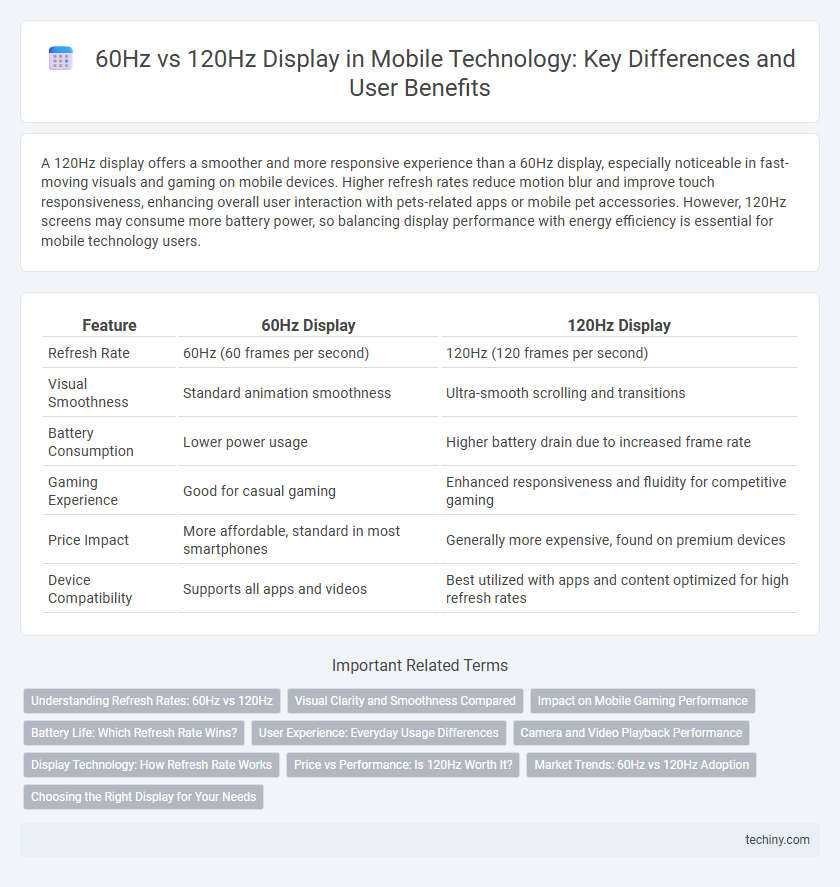A 120Hz display offers a smoother and more responsive experience than a 60Hz display, especially noticeable in fast-moving visuals and gaming on mobile devices. Higher refresh rates reduce motion blur and improve touch responsiveness, enhancing overall user interaction with pets-related apps or mobile pet accessories. However, 120Hz screens may consume more battery power, so balancing display performance with energy efficiency is essential for mobile technology users.
Table of Comparison
| Feature | 60Hz Display | 120Hz Display |
|---|---|---|
| Refresh Rate | 60Hz (60 frames per second) | 120Hz (120 frames per second) |
| Visual Smoothness | Standard animation smoothness | Ultra-smooth scrolling and transitions |
| Battery Consumption | Lower power usage | Higher battery drain due to increased frame rate |
| Gaming Experience | Good for casual gaming | Enhanced responsiveness and fluidity for competitive gaming |
| Price Impact | More affordable, standard in most smartphones | Generally more expensive, found on premium devices |
| Device Compatibility | Supports all apps and videos | Best utilized with apps and content optimized for high refresh rates |
Understanding Refresh Rates: 60Hz vs 120Hz
A 60Hz display refreshes the screen 60 times per second, offering standard motion clarity suitable for everyday mobile use, while a 120Hz display doubles this rate to 120 refreshes per second, providing smoother animations and improved responsiveness in gaming and scrolling. Higher refresh rates reduce motion blur and enhance visual fluidity, significantly benefiting fast-paced activities and user interaction on smartphones and tablets. Devices featuring 120Hz displays often consume more battery power but deliver a noticeably more immersive and seamless user experience compared to 60Hz screens.
Visual Clarity and Smoothness Compared
A 120Hz display offers significantly smoother motion and enhanced visual clarity compared to a 60Hz display due to its higher refresh rate, which updates the screen 120 times per second. This results in reduced motion blur and improved responsiveness, particularly beneficial for gaming and fast-paced video playback. Users experience sharper animations and more fluid transitions, making 120Hz a preferred choice for advanced mobile technology devices seeking superior visual performance.
Impact on Mobile Gaming Performance
A 120Hz display significantly enhances mobile gaming performance by providing smoother motion rendering and faster frame rates compared to a 60Hz display, resulting in reduced motion blur and improved responsiveness. Higher refresh rates lead to more accurate input detection, offering a competitive advantage in fast-paced games like first-person shooters and racing titles. Despite increased power consumption, the visual clarity and fluidity of gameplay on 120Hz screens elevate user experience and precision beyond the capabilities of 60Hz displays.
Battery Life: Which Refresh Rate Wins?
A 60Hz display consumes less power compared to a 120Hz display, resulting in longer battery life for mobile devices. Higher refresh rates like 120Hz offer smoother visuals and improved responsiveness but significantly increase energy consumption. Battery endurance favors 60Hz screens, especially for users prioritizing extended usage over display fluidity.
User Experience: Everyday Usage Differences
A 120Hz display significantly enhances user experience by providing smoother scrolling, more responsive touch inputs, and fluid animations compared to a 60Hz display. This higher refresh rate reduces motion blur and eye strain, making activities like gaming, video playback, and general navigation more immersive and comfortable. Although 120Hz screens consume more battery, the improved visual fluidity offers noticeable benefits in everyday mobile usage.
Camera and Video Playback Performance
A 120Hz display provides smoother video playback and more responsive camera preview compared to a 60Hz display, enhancing real-time image capture and editing. Higher refresh rates reduce motion blur and screen tearing, resulting in clearer video recording and better playback of high-frame-rate content. Mobile devices with 120Hz displays offer superior visual performance for camera apps and video consumption, making them ideal for users prioritizing media quality.
Display Technology: How Refresh Rate Works
A 60Hz display refreshes the screen 60 times per second, while a 120Hz display doubles that rate to 120 times per second, resulting in smoother motion and reduced motion blur. Higher refresh rates enhance the fluidity of animations, touch responsiveness, and overall visual experience, especially in fast-moving content like gaming or video playback. Mobile technology leverages advanced display drivers and synchronization techniques to efficiently manage these higher refresh rates without significantly increasing power consumption.
Price vs Performance: Is 120Hz Worth It?
A 120Hz display offers significantly smoother animations and more responsive touch input compared to a 60Hz display, enhancing gaming and scrolling experiences. However, devices with 120Hz panels generally come at a higher price point and may consume more battery power, which impacts overall device longevity. For users prioritizing fluidity and visual performance, investing in 120Hz is worthwhile, but for budget-conscious consumers, a 60Hz display often provides a satisfactory balance of cost and usability.
Market Trends: 60Hz vs 120Hz Adoption
The mobile technology market is witnessing a significant shift as manufacturers increasingly adopt 120Hz displays over traditional 60Hz screens, driven by consumer demand for smoother animations and enhanced gaming experiences. In 2024, over 65% of mid-range and premium smartphones feature 120Hz refresh rates, reflecting a growing preference for higher refresh rates in emerging markets and flagship devices alike. Market analysis predicts the 120Hz adoption rate will surpass 80% by 2025, dominating new smartphone launches due to advancements in display technology and competitive pricing strategies.
Choosing the Right Display for Your Needs
A 60Hz display refreshes the screen 60 times per second, providing smooth visuals suitable for everyday tasks like browsing and messaging, while a 120Hz display doubles this rate, delivering smoother animations and more responsive touch inputs ideal for gaming and multimedia consumption. Choosing between a 60Hz and 120Hz display depends on your usage patterns, as a 120Hz panel offers enhanced fluidity and reduced motion blur but may consume more battery power. Prioritize a 120Hz display if you engage in fast-paced gaming or multimedia editing, whereas a 60Hz display suffices for general smartphone use and conserves battery life.
60Hz Display vs 120Hz Display Infographic

 techiny.com
techiny.com